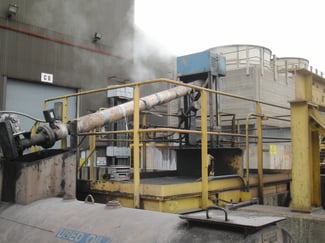In industrial and environmental settings, effectively removing hydrocarbons from fluids is a critical task. The choice of the right oil skimmer and belt material can significantly influence the efficiency of this process. Given the variety of applications and operating conditions, understanding the factors that determine the suitability of different skimming solutions is essential for addressing hydrocarbon contamination. This blog delves into the considerations for selecting the appropriate oil skimmer, belt materials, and associated components to ensure optimal performance in various scenarios.
Application Variables
There are many variables in an application that will dictate which oil skimmer and belt material will work best in removing hydrocarbons from fluids. Key factors include:
- Type of Hydrocarbon: Different hydrocarbons have varying properties that affect skimming efficiency. For instance, light oils may require different handling compared to heavier, more viscous oils.
- Contaminated Fluid: The nature of the fluid being treated can impact the choice of skimmer. Water, for example, behaves differently than other industrial fluids, affecting the skimmer's performance.
- Environmental Conditions: Temperature, weather, and other external factors play a crucial role. Extreme temperatures can influence the viscosity of the hydrocarbons and the performance of the skimming equipment.
- Operational Requirements: Specific needs of the application, such as continuous or intermittent operation, determine the type of skimmer and its features. High-volume operations might need more robust, high-capacity skimmers.
Outdoor Applications and Heating Requirements
In outdoor applications, maintaining the fluidity of the skimmed product is crucial. Considerations include:
- Heaters: Essential for keeping the skimmed product fluid for effective removal, especially in grease skimming where higher viscosity at all temperatures is a challenge. Heaters ensure the hydrocarbon remains in a liquid state for efficient skimming.
- Polymer Materials: Limited in heat tolerance, often requiring only tray heaters. These are suitable for moderate climates but may not perform well in extreme cold.
- Steel Media: Can apply heat to both the tray and the medium, improving performance in severe winter climates. This dual heating capability ensures consistent skimming efficiency even in harsh weather conditions.
- Corrosion Resistance: Stainless steel housing may be needed to resist corrosion. This is especially important in marine or highly humid environments where equipment longevity can be compromised by rust.
- Protection: Above ground enclosures and underground manway mounting kits provide additional protection from the elements, ensuring that the skimming equipment remains operational despite harsh weather conditions. These protective measures can prevent damage from debris, rainfall, and other environmental factors.
Material Considerations for Wiper Blades
Choosing the right material for wiper blades is critical for effective skimming. Common materials include:
- Nitrile: Suitable for use up to 176°F in neutral pH liquids, making it a versatile option for many applications. Nitrile wiper blades offer a good balance of durability and chemical resistance.
- [CRV]: Works well for higher temperatures and acidic or alkaline liquids. [CRV] wipers are designed to withstand more aggressive chemical environments, providing longevity and reliability in challenging conditions.
- Ceramics: Resistant to many chemicals but prone to breakage. Ceramic wiper blades offer excellent chemical resistance but must be handled carefully to avoid damage.

Hazardous Duty Locations
For hazardous duty locations, special considerations are necessary to ensure safety and compliance:
- Explosion-Proof Motors: Mandatory for locations with ignitable fumes to prevent the risk of ignition and ensure safe operation.
- Corrosion-Resistant Motor Housings: Required for sanitary washdown situations in food plants, ensuring compliance with health and safety standards and preventing contamination.
- Electrical Compatibility: Different voltages and power frequencies needed for some plants, requiring careful consideration during the selection process to match the skimmer’s electrical requirements with the plant’s power supply. This ensures seamless integration and optimal performance.
Unattended Operation and Control Options
In many applications, skimmers can run unattended for extended periods. Considerations for control options include:
- Unattended Operation: Typical for groundwater remediation applications at remote well sites, where continuous operation is necessary to manage hydrocarbon contamination effectively. Reliable unattended operation reduces the need for frequent maintenance visits.
- Manual On/Off Switches: Simple control option for starting and stopping the unit, providing straightforward operation.
- 24-Hour Timers: Allows for automated operation at predetermined times, ensuring the skimmer runs at optimal intervals without requiring manual intervention.
- Advanced Controls: Remote monitoring and automation can enhance efficiency and reliability. These systems allow operators to monitor skimmer performance from a distance, receive alerts for any issues, and make adjustments as needed, further reducing the need for on-site personnel.
Choosing the right oil skimmer and associated components involves careful consideration of various factors, including the type of hydrocarbon, environmental conditions, and specific application requirements. By understanding these variables and selecting the appropriate materials and features, it is possible to design an effective and reliable skimming solution that addresses hydrocarbon contamination challenges in diverse settings. Whether dealing with outdoor applications, hazardous locations, or the need for unattended operation, the right skimming equipment can make a significant difference in maintaining fluid purity and operational efficiency. Proper selection and implementation ensure long-term effectiveness, reduce maintenance costs, and enhance overall environmental safety.
To learn more about oil skimmers, please contact our experts at 440-543-7400 or visit our website: www.abanaki.com
You are just one step away from downloading Abanaki's most detailed resource on our oil skimming equipment. Simply click at the button to get your ultimate guide now.



